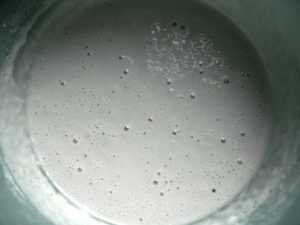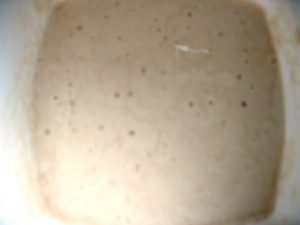Two current events have inspired me to write about sourdough. The first was a wonderful article in the Vancouver Sun “Farm market producers: Great loaves come to those who wait” about a woman who has started a second career as a baker in Langley B.C., specializing in sourdough bread. She uses 15 natural cultures to create her breads and relates a story about how one of her assistants used almost all of a culture and she had to nurse the mother culture back to life from just a spoonful.
The second was an Alaskan cruise with a stop in Skagway and a trip on the White Pass Railroad that follows the White Pass trail to the Klondike Gold Rush. At a tourist stop, I picked up a package o f sourdough starter mix (ingredients: flour, sugar, salt, yeast and potato) which I am using to start my own culture. I had a sourdough pot quite a few years ago but it got pitched in one of our moves so I am keen to try again. (See image at the right for what it looks like so far.)
f sourdough starter mix (ingredients: flour, sugar, salt, yeast and potato) which I am using to start my own culture. I had a sourdough pot quite a few years ago but it got pitched in one of our moves so I am keen to try again. (See image at the right for what it looks like so far.)
Sourdough is the oldest and most original form of leavened bread dating back to the Ancient Egyptian civilizations. In the days before packaged yeast was sold in grocery stores, cooks who wanted yeast-leavened baked goods were forced to rely on various techniques for collecting wild yeasts from the air. Concoctions of potato water and flour were left at room temperature covered with a porous cloth for as long as necessary to attract local yeasts. After some time, bubbles appeared, indicating that wild yeasts were feeding on the flour and converting natural sugar to alcohol and carbon dioxide (the process of fermentation). This yeast batter when kept at cool temperatures develops a distinctive sour tang, and so the mixture became known as sourdough.
Early settlers—and especially prospectors in the American and Canadian gold rushes —were often called “sourdoughs” because of their reliance on their precious pots of yeast batter which they often moved from camp to camp by burying deep in sacks of flour. In the Klondike Gold Rush (1896 -1903) a person was also called a “sourdough” if they spent an entire winter north of the Arctic Circle, and protected their sourdough starter during the coldest months by keeping it close to their body, sometimes even sleeping with it inside their bedroll. Because they dipped into the batter and replenished it daily to make hot cakes and campfire bread, refrigeration was unnecessary.
The old-fashioned sourdough made famous during Gold Rush times (both in the Yukon and in British Columbia) didn’t use milk as none was available on the trail or in the mining camps. A natural yeast start er was made from water enriched with potatoes, or flour and water left out to attract the yeast that is present in the environment. Once the mixture was bubbly, it became the starter or “mother” and it was kept going by adding flour and water. Through trial and error it was discovered which of these sourdough cultures worked and tasted better than others and those cultures would be carefully guarded and nourished. Some have been maintained for years. See image at the right for my first attempt at attracting natural yeast to create sourdough starter.
er was made from water enriched with potatoes, or flour and water left out to attract the yeast that is present in the environment. Once the mixture was bubbly, it became the starter or “mother” and it was kept going by adding flour and water. Through trial and error it was discovered which of these sourdough cultures worked and tasted better than others and those cultures would be carefully guarded and nourished. Some have been maintained for years. See image at the right for my first attempt at attracting natural yeast to create sourdough starter.
Here are a few tips on how to nourish your starter:
- always leave a cup of starter to renew and keep the mother going
- if water forms on the top, stir well and add flour to make a smooth batter again
- never use anything metal – glass, ceramic or plastic for your pot – wooden spoon for stirring
- add equal amounts of flour and water to replenish your starter the night before you are going to bake
- cover your pot lightly
- if you store the starter in the fridge, then bring to room temperature before using to make sure it is working again
Just for fun you might want to check out Stuart MacLean’s Vinyl Café story about Dave “mothering” the neighbour’s sourdough starter or if you have youngsters around look for Susie’s Sourdough Circus by Vancouver Island author, Kathy Sager a delightful, imaginative, rhyming story describing how Suzie and her father bake sourdough bread each week, complete with recipes.
Caring for your sourdough starter or “mother” and enjoying the results is a great way to eat our history, and connect to the early pioneers and settlers in this province. We’ll explore recipes for sourdough in another post.
